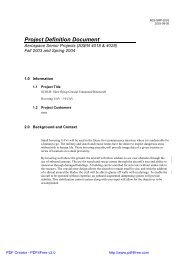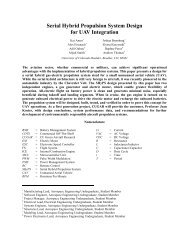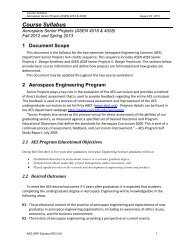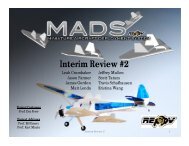PFR - Aerospace Engineering Sciences Senior Design Projects ...
PFR - Aerospace Engineering Sciences Senior Design Projects ...
PFR - Aerospace Engineering Sciences Senior Design Projects ...
Create successful ePaper yourself
Turn your PDF publications into a flip-book with our unique Google optimized e-Paper software.
Project Final Report – CUDBF April 30 th , 2009<br />
ASEN 4028: <strong>Aerospace</strong> <strong>Senior</strong> <strong>Projects</strong><br />
apparatus to both protect the device as well as maintain the integrity and shape of the wing. A<br />
small balsa plate was glued into the servo cavity which allows the servo to be screwed into place.<br />
Wiring for the rudder, aileron, and release mechanisms was placed in the hole created for it, and<br />
enough run through the wingtip to attach the vertical, aileron, and wingtip to the main wing. The<br />
balsa spar and hinge system was then glued into place on the wingtip. Great care was taken to<br />
ensure that the balsa spar and hinge were properly placed and aligned within the wingtip such<br />
that no twist or different angles of attack are introduced to the final aircraft.<br />
Once the spar, wiring, and release mechanisms were installed, the release mechanisms were tied<br />
to the servo with Kevlar string and paper was taped over all hollows to prevent glue from<br />
spreading into the hollows. The wingtips were then sheeted with balsa in the same manner as the<br />
verticals. The wiring and release mechanisms were tested after sheeting to ensure no glue spread<br />
to the system. Rubber sections were then cut to fit the airfoil shape at the wingtip folding edge<br />
(this provided some degree of pre-stress for the hinge system). Balsa sheets were first fitted to<br />
the wingtip edge, and the thin rubber airfoil shapes glues to the wingtip. The location where the<br />
wingtip stores connect to the aircraft via magnets was then hollowed out to allow the rocket<br />
magnet to directly contact the installed metal. Next, a small hollow was created for the aileron<br />
control servo and the servo installed. Like holes were then drilled into the trailing edge which<br />
matches those created for the aileron. The aileron hinges were glued into place, servo linkages<br />
were attached to the aileron, and the control surfaces tested.<br />
12.4 Main Wing Sub-Assembly<br />
Figure 109: Main Joined Wing Assembly<br />
Once the cut along the aircraft fold location was made, the main wing could be built in tandem<br />
with the wingtips. The elevators were removed first using a bandsaw, and the elevators sheeted<br />
and sanded. These control surfaces were then monokoted and holes drilled along the leading<br />
edge. Small hinges similar to the ones used in the rudder and aileron were then installed, and the<br />
elevator was then set aside until later. In the wing, sections where the motors are placed were<br />
removed from the wing and balsa mounts integrated. The mounts were made by shaping blocks<br />
carefully to maintain wing shape and tightly hold the metal motor mounts which directly house<br />
the motors. Once these were glued into place, the wing halves were sheeted. While the wings<br />
127
















